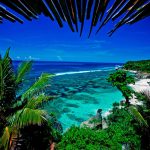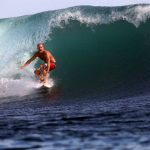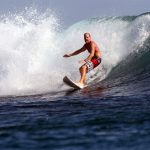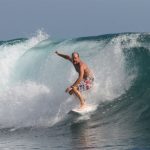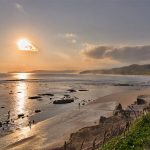
Sumba Island Surfing Breaks Information
Being on Sumba you can experience one of the world’s more challenging surfing waves close to the hotel. Kerewe, Marosi and Dasang are beaches facing south in to the Indian Ocean and therefore the surf is very consistent.You will be a forerunner for those spots that still few people have discovered.
Located in the Lesser Sunda Island chain in Southeast Indonesia, just a hair east of Bali, Sumba is a beautiful island with a rich cultural tradition, and is home to world class waves. Not highly accessible, it’s not on everyone’s hit list. As with other surf destinations in Indonesia, it is blessed with great surf much of the year, particularly April through October.
WEST SUMBA SURFING
Nihiwatu Surf
Nihiwatu is a destination for surfers to bring their partners or families and do whatever they want in style and serious comfort. Nihiwatu is situated on one of the premier lefts in Indonesia, and the resort restricts the number of surfers booked into the resort to only 9 at any one time.
There is no doubt that Nihiwatu is one of the top waves in Indonesia and the world. The professional surfers who have visited Nihiwatu over the years have attested to this. There have been several surf movies made here with the arraignment of the owners and with the agreement that the filmmakers and photographers would not name the location.
Nevertheless the word has leaked out and now there is a cult following of surfers who know about Nihiwatu. In some circles Nihiwatu has already achieved legendary status.
Just 100 yards off of Nihiwatu beach is one of the world’s most perfect waves. Guests of ours have the added benefit of riding, or just watching, the incredible surf breaking on the reef directly in front of the resort.
Nihiwatu faces southwest into the Indian Ocean and is ideally suited for picking up swell arriving from thousands of miles away; the surf here is very consistent. If the surf is flat here you can be sure it is flat just about everywhere else in the archipelago.
Many professional surfers have visited Nihiwatu over the years and several surf movies have been filmed here featuring the 1999 world surfing champion Mark Occhilupo. If you are seeking large double overhead surf the best times are during the months of May through October on the full and new moons. In between those times we often have perfect waves in the three to six foot range.
The Waves and The Reefs
The wave breaks from deep water onto a shallow reef directly in front of the resort, tubing from start to finish. It is thick and steep on the takeoff and sucking a lot of water up the face. Nihiwatu is one of the fastest rideable waves anywhere, taking only six to ten seconds to travel the 250+ yard length of the wave.
This is not a hot dogging wave, it is full on down-the-line surfing. One slight mistake and you probably won’t make it to the channel. Nihiwatu breaks best at 4′ and above and the bigger the swell the better the wave becomes. 8′ to 10′ swells are common here and there are usually several 12’+ swells each year.
The coral reef is relatively surfer-friendly. The coral is pounded flat by the waves and hitting the bottom does not necessarily mean getting cut. In fact over the past twelve years there have been very few surfers with reef cuts and no serious injuries.
Access
The wave breaks 80 yards off the beach and ends in a deep channel. The setup is ideal and paddling out through the channel is easy without having to punch through the waves at all. If you do not make the wave the sweep of the water over the reef will push you back into the channel very quickly.
Tides
Tides in Indonesia change only about three feet during neap tides and up to 8 feet during the full and new moon periods. The wave at Nihiwatu has different personalities depending on the tide. At extreme high tide the wave is fuller and much easier to ride, perfect for surfers who are not accustomed to fast tubing waves. On extreme low tide, during the full and new moon periods, the wave breaks onto dry reef and is un-rideable except for the 50-yard end section. These extreme tide periods occur four days before and three days after the new and full moons. It is during these periods that surf can almost be guaranteed at Nihiwatu.
Typically the novice surfers go out at high tide with the accomplished surfers preferring to go out for the two to three hours of mid tides on either side of the peak high tide. That’s when its serious tube time at Nihiwatu. During the neap tides the change is minimal and does not affect the wave at all, one can surf all day on the high and low tides. These really are the optimum tides, providing there is swell.
Wind
Nihiwatu resort is protected from the prevailing crosswinds during the months of March to December. Unlike Bali, the trade winds do not blow day and night and for months on end. There can be periods of strong wind for four or five days then followed by very light wind conditions, even when it is blowing hard in other parts of Indonesia. Generally the peak winds will occur during the months of June, July and August although we have experienced a whole month of July with no strong winds at all.
When it is blowing hard the wave will be affected. Not by the wind on the wave, which is cross shore on the take off and offshore on the last half of the wave, but by a wind swell that comes from outside of the point and crosses the face of the wave during take off. It makes for tricky take offs, but once on the wave the face cleans up nicely and keeps tubing.
Even during the peak wind conditions the wind will be offshore in the morning before turning side shore by around 10am. During the worst conditions the wave will become blown out between 12:30 to 2 pm. This does not happen regularly but when it does then its time to try other activities like horseback riding on the beach, fishing and scuba diving, bird watching, mountain biking, trekking to a waterfall, relaxing at the pool or having a massage at the Jungle Spa.
SURF SPOT IN EAST SUMBA
The office
point break-like lefthander is the most consistent wave here. Works on all tides except max high and breaks eventually onto sand. Miles of beach break from here.
Racetrack
A wedgy left that accelerates and builds in size down the line , truly lives up to its name.
Five-O
Good lefthand barrel breaking along bend of reef into the main channel. It needs a six-foot swell to start breaking and is surfed at higher or dead low tide.
Manggudu Island waves
The island sits on the edge of very deep water and the waves can get very big. The western tip has a left and eastern a righthander. The left is a swell magnet with the dry season trade winds blowing offshore. Consistent overhead surf, bring a gun.
The left
The reef is large and the wave is best described as “sunset-like”. After peaking, it will bowl through hollow sections or just wall off right from the take-off, depending on swell direction. Can handle very big swell.
The Right
long wave that wraps all the way around the eastern tip of the island. Mellower wave than the left, but longer and hollower. Wet season wave, but you might get lucky on some mornings during the dry season before the winds come up.




